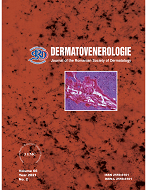Summary
Introduction: Aneurysmal dermatofibroma is a benign mesenchymal tumor of the skin, representing < 2% of all histologic types of dermatofibromas, with a predilection for women and mostly occurring on the legs. The etiology is still unknown, but the association with local trauma and insect bites suggests a reactive process. However, recent cytogenetic data and multiple dermatofibromas in immunosuppressed population are arguments for a neoplastic origin.
Case report: A 71-year-old woman presented with an erythematous and ulcerated nodule of 14 mm in diameter on the left calf following an insect bite 5 years ago. The lesion was treated with local antibiotics and antihistaminic drugs, but with no favorable results. The medical history of the patient revealed insulin-dependent diabetes mellitus, arterial hypertension, and ischemic heart disease. In 2009, the patient was diagnosed with non-Hodgkin’s lymphoma and treated with standard chemotherapy until 2016. The histopathological examination of the excisional biopsy of the left calf nodule demonstrated an aneurysmal dermatofibroma, characterized by cleft-like hemorrhagic spaces within the dermis, that mimic vessels but lack an endothelial lining. The composite lesional cells were seen in fascicles and storiform arrangement, with no cytonuclear atypia. The Grenz zone (sparing of the superficial papillary dermis) was observed. Perls’ Prussian Blue staining highlighted in green intra- and extracellular hemosiderin
depositions.
Conclusions: The particularity of the case is the presence of both possible and in opposition etiological factors - insect bite and immunosuppression, in the context of non-Hodgkin’s lymphoma, in an old woman patient. Complete evaluation and multidisciplinary approach of these patients is necessary, considering the aneurysmal histologic subtype of the dermatofibroma, associated with a higher risk of local recurrence, and the possibility of the appearance of multiple dermatofibromas in immunosuppressed populations.


